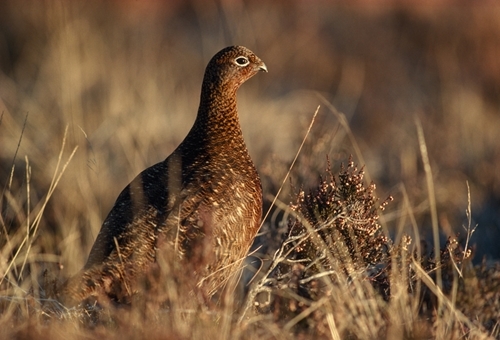
Photo: Laurie Campbell
This Saturday marks the opening of the grouse shooting season, but for many Scottish moors the Twelfth of August 2023 is set to be far from ‘Glorious’.
Annual counts are essential for determining whether there is a harvestable surplus of birds, and when it comes to counting grouse, consistency is key. The Game & Wildlife Conservation Trust has been monitoring red grouse at the same sites for over 40 years. Spring counts tell us the pre-breeding density, whilst July counts help determine breeding success, and allow harvest predictions to be made, this in turn informs how many days shooting can be had.
This year in Scotland, just three staff and 7 pointing dogs (a mixture of pointer, setter, and HPR breeds) have surveyed over 30 sites, each one of approximately 100 ha. On-site, we walk six equally spaced parallel transect lines through the count area, whilst the dog “quarters” on either side of the transect line hunting grouse by scent. The dog points when a grouse is located, allowing the observer to walk to the point, flush the birds and record the number, age, and sex.
In 2021, poor quality habitat and an exceptionally cold spring resulted in hens being in poor nutritional condition, which may have been partially to blame for the difficult season. Whilst last year was a better year for many, most viewed 2022 as a chance to carefully build stock. However, despite the milder spring, we experienced this year, the unusually hot and dry period around hatching has likely contributed to the poor fledgling success that has been observed on many Scottish moors.
This has been reflected in our annual counts. Although there is much variation between moors, and even between beats, on average our count sites have shown a 10% decrease in post-breeding densities compared with 2022.
No two moors are the same and this year we have seen considerable variation between estates and even between beats. There are several known factors that impact how well red grouse breed including habitat conditions, invertebrate food availability, and predation. In some parts, disease and rising numbers of parasites (tick and strongyle worms) have also undoubtedly contributed to the differences in breeding success between sites.
Each year, estates rely on our Upland Advisory Service to provide expert insight into disease management and population monitoring. We offer a complete health and disease service covering both Louping-ill and Strongylosis testing, along with thorough advice on heather management and grazing strategies. The expertise provided by our advisors can help assist with harvesting analysis and inform current moorland management practices. A forensic look at everything may be more important than ever given the expectations of success for this year on many Scottish moors.
For more information about disease and population monitoring in red grouse, please contact Hugo Straker (hstraker@gwct.org.uk | 07713 074147) or Nick Hesford (nhesford@gwct.org.uk | 07896 006332).